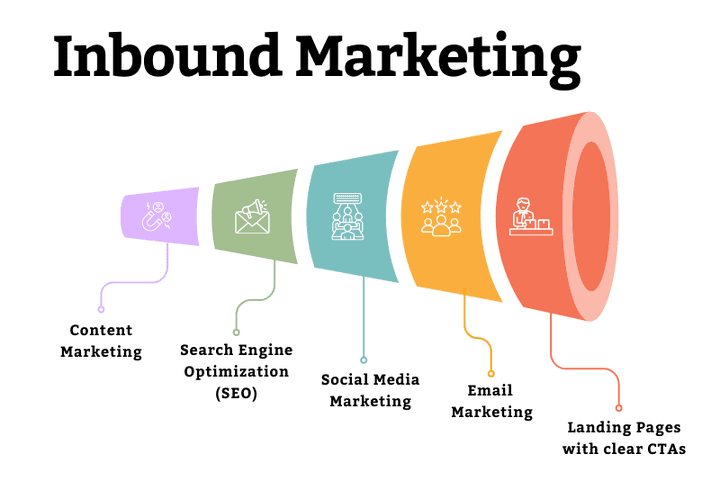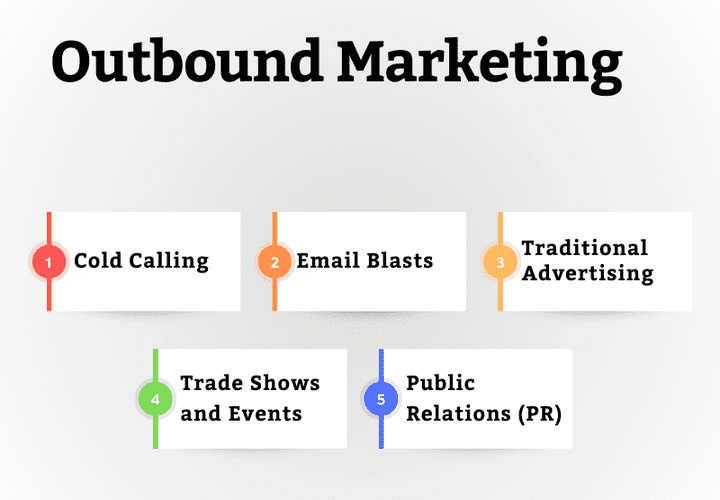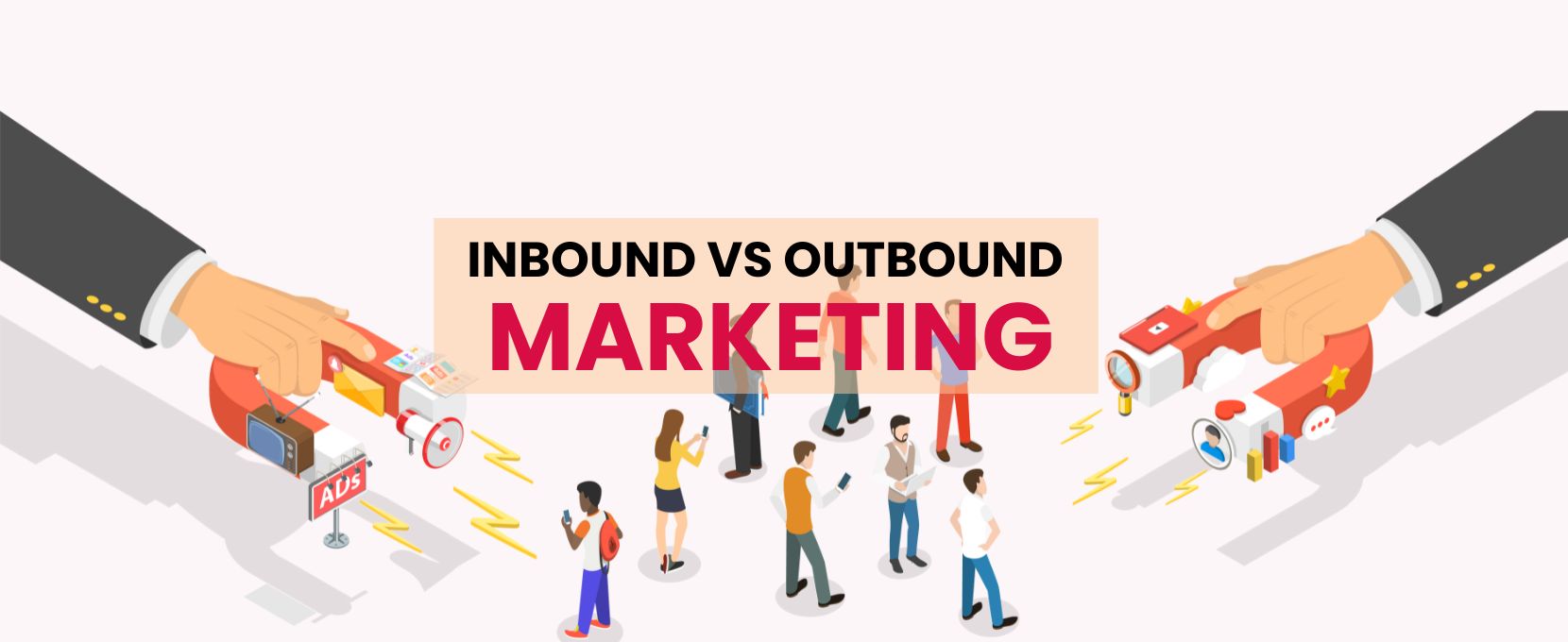Inbound vs Outbound Marketing Demystified (5 Key Differences)
In today’s digital age, businesses have a wealth of options when it comes to reaching their target audience. But with so many marketing strategies available, it can be overwhelming to choose the right approach. Two prominent methods stand out: inbound vs outbound marketing.
This comprehensive guide dives deep into the differences between inbound and outbound marketing. We’ll explore their core principles, benefits, and ideal applications. Also, this guide will equip you with the knowledge to make informed decisions about your marketing strategy and ultimately attract, engage, and convert your ideal customers.
Defining the Strategies – Inbound vs Outbound Marketing
Inbound Marketing
Inbound marketing is a customer-centric approach that focuses on attracting prospects through valuable content, personalized experiences, and nurturing relationships. Instead of interrupting potential customers with intrusive messages, inbound marketing aims to provide relevant and helpful information that aligns with their interests and needs. Key tactics of inbound marketing include content marketing, search engine optimization (SEO), social media engagement, email marketing, and lead nurturing.
Outbound Marketing
In contrast, outbound marketing, also known as traditional or interruption marketing, involves pushing promotional messages to a broad audience in hopes of generating immediate sales or leads. Examples of outbound marketing tactics include television and radio advertisements, print ads, cold calling, direct mail, and email blasts to purchased lists. Unlike inbound marketing, which focuses on earning the attention of prospects, outbound marketing relies on interrupting consumers to deliver its message.
Understanding the Core Differences: Inbound vs Outbound Marketing
The fundamental distinction between inbound and outbound marketing lies in their approach to customer interaction. While both inbound and outbound marketing aim to generate leads and sales, they take fundamentally different approaches. Hence, understanding these differences is crucial for crafting an effective marketing strategy.
- Inbound Marketing: This strategy focuses on attracting potential customers by creating valuable content and building relationships with them over time. It’s all about drawing them in, nurturing their interest, and guiding them through the buyer’s journey organically. This approach often involves content marketing, SEO, social media marketing, and email marketing.
- Outbound Marketing: This method takes a more proactive approach. It involves directly reaching out to potential customers through tactics like cold calls, email blasts, or traditional advertising. It aims to generate immediate interest and awareness of a product or service. Examples include cold calling, email marketing (purchased lists), TV commercials, billboards, and trade shows.
Here’s a table summarizing the five key differences between the two marketing strategies:
Inbound Marketing | Outbound Marketing | |
Approach | Attract | Push |
Focus | Building relationships, providing value | Generating leads, brand awareness |
Examples | Blog posts, social media content, SEO, webinars | Cold calls, email blasts, TV ads, billboards |
Cost | Can be cost-effective in the long term | Can be expensive upfront |
Results | Sustainable growth, qualified leads | Faster initial results, but may not be as long-lasting |
Choosing the Right Approach
The ideal marketing strategy depends on several factors. These include your industry, target audience, budget, and business goals. Here are some scenarios where each approach might be most effective:
- Inbound Marketing: Well-suited for businesses with a long-term perspective. Ideally, those targeting specific customer segments online, and companies offering complex products or services that require education and nurturing leads.
- Outbound Marketing: More suitable for businesses with short-term lead generation goals. So, they can be the ones targeting a broad audience through traditional media channels, or companies offering readily understood products or services.
It’s important to note that inbound and outbound marketing can be even more powerful when used together.
A well-rounded strategy might combine targeted social media campaigns (inbound) with industry event sponsorships (outbound) to create a comprehensive and effective approach.
The Benefits of Inbound Marketing
Inbound marketing offers numerous advantages that make it a compelling choice for many businesses. Here are some key benefits:
- Cost-Effectiveness: Inbound marketing can be highly cost-effective in the long run. By creating valuable content, you attract qualified leads who are already interested in your product or service, reducing wasted efforts and improving conversion rates.
- Sustainable Growth: Inbound marketing helps build trust and authority within your industry. As you create valuable content and engage with your audience, you establish long-term relationships with potential customers, leading to sustainable growth.
- Targeted Audience: Inbound marketing allows you to target specific demographics and interests. By tailoring your content and outreach efforts, you attract qualified leads who are more likely to convert into paying customers.
- Measurable Results: Inbound marketing allows you to track and analyze your results effectively. So, you can monitor website traffic, social media engagement, and lead conversions to measure the success of your campaigns and make data-driven decisions for improvement.
- Improved Brand Reputation: By consistently creating high-quality content and providing valuable insights, you position your brand as an authority in your field, fostering trust and loyalty among your target audience.
The Advantages of Outbound Marketing
Despite the rise of inbound marketing, outbound marketing strategies still hold value in specific situations. Here are some benefits to consider:
- Faster Lead Generation: Outbound marketing tactics like cold calling or email blasts can generate leads quickly. This can be helpful for businesses needing a faster influx of leads or those with shorter sales cycles.
- Wider Reach: Outbound marketing can reach a broad audience, including those who may not be actively searching for your product or service online. This can be beneficial for reaching new market segments or promoting brand awareness initiatives.
- Targeted Messages: Outbound marketing allows for targeted outreach based on specific demographics or business needs. So, you can tailor your message to resonate with the chosen audience segment.
- Control Over Messaging: With outbound marketing, you have complete control over the message you convey to your target audience. This allows you to highlight specific features or benefits of your product or service in a direct and impactful way.
- Integration with Inbound Strategies: Outbound marketing can be a powerful complement to an inbound strategy. For example, a cold email campaign can direct recipients to a relevant blog post or landing page, further engaging them within the inbound funnel.
Exploring the Tools and Techniques: Inbound vs Outbound Marketing
Inbound Marketing

- Content Marketing: Create valuable and informative blog posts, articles, infographics, videos, and eBooks that address your target audience’s pain points and interests.
- Search Engine Optimization (SEO): Optimize your website content and online presence to rank higher in search engine results pages (SERPs), attracting organic traffic through SEO.
- Social Media Marketing: Engage with your audience on social media platforms like Facebook, LinkedIn, and Twitter by sharing valuable content, running targeted ads, and fostering conversations.
- Email Marketing: Build an email list and nurture leads with targeted email campaigns that provide valuable information, promote offers, and ultimately guide them towards conversion.
- Landing Pages: Create targeted landing pages with clear calls to action (CTAs) to capture leads and convert website visitors into customers.
Outbound Marketing

- Cold Calling: Directly reach out to potential customers via phone calls to introduce your product or service and generate leads.
- Email Blasts: Send targeted emails to a purchased or opted-in email list to promote your offerings and drive website traffic or sales.
- Traditional Advertising: Utilize television commercials, print ads in magazines or newspapers, and billboard placements to reach a broad audience and increase brand awareness.
- Trade Shows and Events: Participate in industry conferences and trade shows to connect with potential customers, showcase your products or services, and network with other businesses.
- Public Relations (PR): Develop strategic relationships with journalists and media outlets to secure positive press coverage and enhance brand reputation.
Inbound vs Outbound Marketing – Key Considerations and Best Practices
For Inbound Marketing
- Content is King: Focus on creating high-quality, informative content that resonates with your target audience and addresses their specific needs.
- Consistency is Key: Maintain consistent content creation and engagement efforts to build momentum and keep your audience coming back for more.
- SEO Optimization: Integrate relevant keywords and optimize your content for search engines to improve organic discoverability.
- Data-Driven Approach: Track and analyze your inbound marketing performance to identify what’s working and adapt your strategy for continuous improvement.
- Building Relationships: Engage with your audience in comments, social media interactions, and email communication. Foster a sense of community and build trust.
For Outbound Marketing
- Targeted Outreach: Qualify your leads and target your outbound efforts to maximize the chances of successful interactions.
- Compelling Messaging: Craft clear, concise, and persuasive messages that capture the recipient’s attention and address their needs.
- Compliance: Ensure all outbound marketing activities adhere to anti-spam regulations and ethical marketing practices.
- Omnichannel Integration: Integrate outbound tactics with your broader marketing strategy, potentially directing leads to valuable content or landing pages for further engagement.
- Measurement and Tracking: Track the effectiveness of your outbound campaigns and adjust your approach based on the results.
The Power of Combining Strategies
By strategically combining inbound and outbound marketing techniques, you can create a powerful marketing force that attracts, engages, and converts your ideal customers.
Here are some tips for integrating inbound and outbound marketing successfully:
- Lead Nurturing: Once you generate leads through outbound efforts, nurture them with valuable inbound content. Consequently, guide them through the buyer’s journey and convert them into loyal customers.
- Data-Driven Decisions: Use data from both inbound and outbound campaigns to identify the most successful channels and messaging, informing your overall marketing strategy.
- Building Brand Consistency: Maintain a consistent brand voice and message across all your inbound and outbound marketing efforts. This will help create a unified branding experience.
- Retargeting: Utilize retargeting campaigns to re-engage website visitors who may have interacted with your brand through outbound channels but haven’t converted yet. This allows you to stay top-of-mind and drive them further down the sales funnel with relevant inbound content.
Global Marketing Firm: Your Partner in Growth
In today’s dynamic marketing landscape, navigating the intricacies of inbound and outbound marketing on your own can feel overwhelming. But fret not! Here at Global Marketing Firm, we’re a team of passionate marketing experts well-versed in both inbound and outbound strategies. We take the time to understand your unique business goals, target audience, and budget.
GET IN TOUCH FOR A
Free Consultation
Through a collaborative approach, we’ll help you craft a customized marketing strategy that seamlessly blends the power of attraction and interruption. From developing captivating content that resonates with your audience to executing targeted outbound campaigns that generate qualified leads, we’ll be your partner in achieving sustainable growth and exceeding marketing objectives. Don’t settle for a one-dimensional approach – let Global Marketing Firm unlock the full potential of your marketing efforts!
Conclusion – Inbound vs Outbound Marketing
In the ongoing debate of inbound vs. outbound marketing, there’s no one-size-fits-all solution. Instead, businesses must strike a balance between the two approaches. This can be done by keeping their objectives, target audience, industry, and resources in mind. We’ve learnt that inbound marketing excels at building trust, engagement, and long-term relationships. Whereas outbound marketing can be effective for driving immediate results and reaching a broader audience.
By understanding the strengths and limitations of each approach, businesses can craft a comprehensive marketing strategy that leverages the best of both worlds. Whether you’re attracting prospects with valuable content or reaching them with targeted promotions, the key is to deliver messages that resonate with your audience and provide value at every touchpoint.
In the dynamic landscape of digital marketing, the synergy between inbound and outbound tactics holds the power to captivate audiences, drive conversions, and propel business growth in the digital age. So, embrace the power of both inbound and outbound marketing, and unlock new opportunities to engage, inspire, and convert your audience with precision and purpose.
While inbound and outbound marketing offer distinct advantages, the most effective approach often lies in combining both strategies. A well-rounded marketing plan leverages the strengths of each method to create a comprehensive strategy that attracts qualified leads, fosters brand awareness, and drives long-term sustainable growth.



